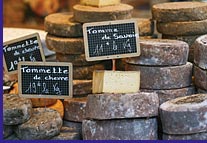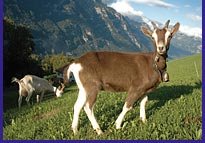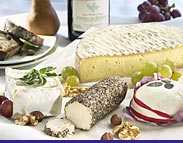From Market to Fromage Plate, “Queen of Cheeses” is a Reigning Classic
 Although “brie” has come to be a common descriptor for any bloomy-rind, soft French cheese, “true” Bries hail only from their titular French region, and have a distinctive flavor that sets them apart. The savory, creamy, sour-milk flavors of Brie de Melun, Brie de Meaux or Brie de Nangis have long made Brie, dubbed France’s “Queen of Cheese,” the most widely sold soft-ripened cheeses in supermarkets.
Although “brie” has come to be a common descriptor for any bloomy-rind, soft French cheese, “true” Bries hail only from their titular French region, and have a distinctive flavor that sets them apart. The savory, creamy, sour-milk flavors of Brie de Melun, Brie de Meaux or Brie de Nangis have long made Brie, dubbed France’s “Queen of Cheese,” the most widely sold soft-ripened cheeses in supermarkets.
Though traditionally made with raw cow’s milk, Brie is pasteurized for export and sale to the United States. While many inferior, factory-made and industrial cheeses manage to reach the market under the name of “Brie”, many Brie de Meaux-style cheeses (often called Fromage de Meaux) sold in the U.S. emulate the authentic raw-milk taste. For instance, Fromage de Meaux, although pasteurized, achieves a praiseworthy full-flavor and earthy bite. According to Vincent Maniaci, “Fromage de Meaux has a good acidity and a nice thin rind, so your palate is not inundated with too much of the mushroom notes which a thick rind would give.”
When shopping for Brie at your local market, make sure you are purchasing Brie deserving of its royal moniker.
Packaging: Always check cheeses for name, origin and producer. The label will indicate whether the source is a farmhouse, local dairy, co-op, or factory. Look for official seals or symbols on the wrapper or box, or stamped on the cheese itself — including a sign that indicates the cheese meets French AOC standards, the certification that ensures its geographical origin. While the name Brie de Melun must be AOC, for instance, the name “brie” is unprotected, and can be used to name mass-marketed cheeses that aim for maximum shelf life, not those from France’s Brie region.
Appearance: Cheese will always let you know where it is in its lifespan. Warning signs are discoloration, odd texture, or the smell of ammonia. The rind should be roughish, light brown, and covered in white mold. A classic French Brie becomes slightly rusty on the rind, but the pâte (the creamy part of the cheese inside the rind) should look light and fluffy and have the appearance of a light yellow creamy paste. There should never be grey on the edges between the rind and the cheese.
Cut: True Bries cannot be pre-cut and pre-packed; doing so would cause them to die within days. Sensitive to long periods in plastic wrap, all Bries should be cut to order if possible. While pre-packaged, plastic-wrapped Brie is a reality for most markets, such portioning should be done daily — ask your merchant!
Aeration: Packaging should both protect and aerate soft-ripened cheeses, and, due to the quest for extended shelf life, aeration blunders can be common. True Bries shouldn’t have a rind that is so white and so fluffy that it is not allowing the cheese to release the gasses. A light and fluffy pâte is an indicator of adequate aeration, but make sure its small holes haven’t started to collapse — that’s a clear indication that the fat and proteins have broken down.
What to ask for: If possible, speak to the person responsible for selecting and obtaining the cheeses at your market. As a consumer, don’t worry about inquiring about the finer points of affinage or storage, but do take any recommendations or opinions that are offered. Also, if the market is set up for tasting, ask for a taste — they should always be offered readily upon request. Quality Brie should taste rich and mushroomy, almost meaty, and never like bland plastic.
Taking it home: Consume Brie on the day or evening of purchase. Buy less not more; plan for 1-1½ ounces of Brie per person, and less for a tasting that incorporates other cheeses. Visit the wine selection on your way out. Reds pair best with Brie — try a Chilean Merlot, Beaujolais (Red) or a southern French Syrah.






